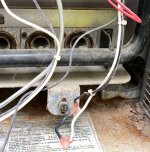- Sep 21, 2007
- 121
- Pool Size
- 96000
- Surface
- Vinyl
- Chlorine
- Salt Water Generator
- SWG Type
- Hayward Aqua Rite (T-15)
We had our pool installed 16 yrs ago with a Hayward H250 heater (millivolt system). We actually only use it 2-3 times a year and each time is a struggle.
At the beginning of the year it takes about 5 minutes of holding the gas valve on 'PILOT' to keep the pilot light from extinguishing,.
Whenever I do turn the heater ON, its seems a struggle. Tonight I approached it systematically. I followed the troubleshooting guide in the manual. Pool pump ON, Pilot light lit, gas valve ON, thermostat set higher than pool water. When I jumper across the TH terminals on the gas valve, the burner lights. When I remove the jumper wire, the burner STAYS LIT. My understanding is that jumping across the TH terminals on the gas valve jumps across all components. The troubleshooting continues to determine which of the components is defective by jumping across each component until the burner stays lit.
My burner stays lit without jumpers, it just didn't start until I jumpered the all the components.
Given the rare times we use the heater, I have no problem starting the heater every time this way, but if I did want it fixed where would I start? Is this a safety concern?
Thanks,
Carl
At the beginning of the year it takes about 5 minutes of holding the gas valve on 'PILOT' to keep the pilot light from extinguishing,.
Whenever I do turn the heater ON, its seems a struggle. Tonight I approached it systematically. I followed the troubleshooting guide in the manual. Pool pump ON, Pilot light lit, gas valve ON, thermostat set higher than pool water. When I jumper across the TH terminals on the gas valve, the burner lights. When I remove the jumper wire, the burner STAYS LIT. My understanding is that jumping across the TH terminals on the gas valve jumps across all components. The troubleshooting continues to determine which of the components is defective by jumping across each component until the burner stays lit.
My burner stays lit without jumpers, it just didn't start until I jumpered the all the components.
Given the rare times we use the heater, I have no problem starting the heater every time this way, but if I did want it fixed where would I start? Is this a safety concern?
Thanks,
Carl
Last edited:


